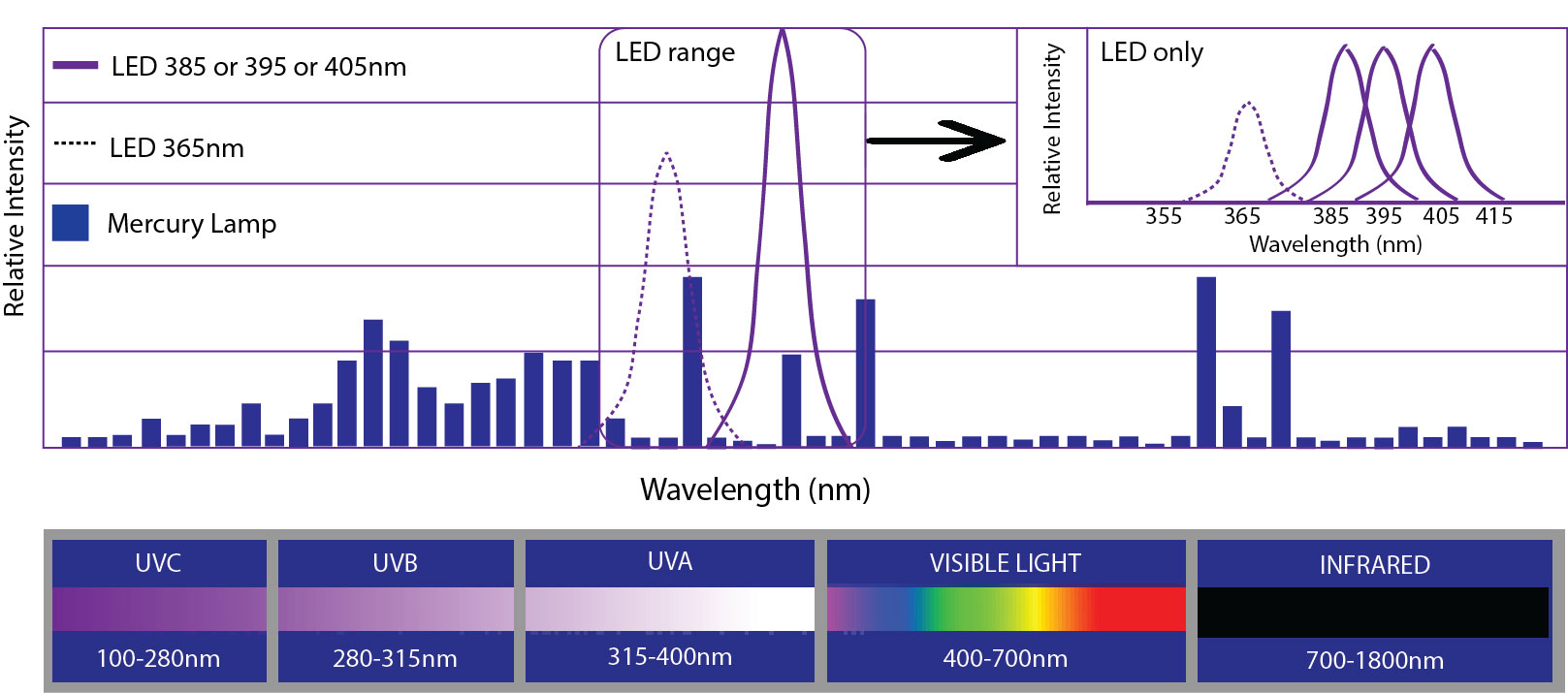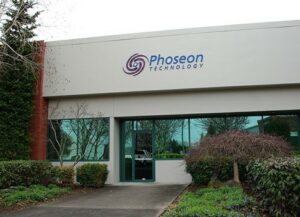In honor of Phoseon Technology’s 20-year anniversary, we thought it would be fun to tell the story of how the company started out and how we got to where we are today.
HOW DID PHOSEON START OUT?
The etymology of “Phoseon” references “long-lasting light,” conveying reliability, endurance, and our long-term commitment to deliver to the world highly efficient industrial light sources dramatically reducing energy consumption and reducing environmental impact.
Phoseon was founded in 2002 to develop semiconductor-based light sources for use in ultraviolet curing and other manufacturing processes. The intent was to develop “a horizontal technology” that can be used in many applications across a wide variety of industries that would replace the incumbent mercury-based lamps.
One of the early applications we pursued was for CD/DVD printing. In 2006, Werner Kammann Maschinenfabrik GmbH introduced a digital printer that finishes compact discs and DVDs. As part of the system, Kammann incorporated Phoseon’s products. Unfortunately, compact discs were replaced by newer technology and that market segment did not grow as expected. As a result, we decided to develop UV LED curing products for inkjet printing. This was a straightforward, but important step since we were already talking to the inkjet players.
HOW DID YOU GET STARTED IN THE INKJET PRINTING MARKET?
We discovered that mercury cured inkjet printing had a number of draw backs with the available curing techniques in terms of heat generation and maintenance which could be effectively addressed by UV LED. We thought there was an opportunity in this market, but to fully take advantage of the LED curing materials needed to be optimized for LED’s monochromatic light. We needed to find partners that were sufficiently motivated to develop the correct UV curable inks, coatings, and adhesives to work with us. We found a problem that needed solving but did not immediately have the total solution. All we needed to do was bring all these factors together with the right curable materials and UV LED would become the right light source for most digital printing applications.
We learned that there are three key components of a UV LED curing system when optimized that provide a breakthrough solution to the printing industry:
1) UV curable materials (inks) that preferentially absorb energy in the UV-A region to undergo polymerization process.
2) UV LED curing lamp that provides energy in the UV-A region of the spectrum, and
3) a printer where the UV LED lamp is properly integrated to cure material underneath it. These elements together provide a long-term sustainable printing method. We sought out to find material partners to formulate inks that work with the narrow wavelength of the LED products.

Ink formulation for LED technology has evolved significantly over time, and today all the major suppliers have inks that work with LED technology. Material suppliers have responded to the demand and challenge in the printing world to formulate raw materials that absorb energy corresponding to output wavelength of UV LED curing units. One of the key ingredients in the chemical formulation is a photo-initiator that serves as a catalyst to initiate the polymerization process when exposed to narrow spectrum UV LED energy. With the continued wide-spread acceptance of UV LED systems, availability of suitable base materials continues to grow.
DID ANYONE ELSE OFFER UV LED CURING FOR INKJET PRINTING?
Phoseon pioneered UV LED curing technology for the inkjet market and remains a leader today. Phoseon is based in Oregon and has a major presence worldwide in inkjet printing, flexographic printing, pad, and screen printing. Coatings and adhesives are also cured by Phoseon lamps around the world. We have highly qualified salespeople with technical backgrounds and they are able to serve both OEM and large industrial end-user sales.
WHAT HAS BEEN YOUR APPROACH TO PRODUCT DEVELOPMENT?
Since the beginning, we have been very collaborative with end users to ensure we have the right technology. We take what we learn from actual use in the market and apply it to our product development, so our products are robust and industrialized. Over the years we have been pushing the boundaries of LED technology. We have had UV LED curing systems running for more than 70,000 hours in our life test lab that are still over 80% output!
Our large and robust product portfolio is based on our learnings over time which continues to grow. The strength of the product is in the accumulated knowledge and the application of that knowledge over time. This is a laborious process that the entire Phoseon team participates on and is that the core of how Phoseon serves the market.
HOW HAVE YOU GROWN AS A BUSINESS?
We have grown over the years due to carefully listening to our customers and what they are telling us; and then create, manufacture, and adapt where necessary. We have been successful in dedicating our initial efforts to UV LED curing for digital printing and growing our business from there. Typical of many new technologies there needed to be a “starting‐point” where a specific benefit of the new technology “out‐ weighs” the traditional method. UV inkjet applications (particularly on heat‐sensitive substrates) were an early and clear success for the UV LED curing lamps. Continued development has enabled the UV LED based curing lamp to be the best overall solution for UV inkjet curing applications.
After finding success in the digital inkjet printing market, we have also developed a substantial UV LED curing business in screen printing, flexographic printing, industrial coatings, and adhesive bonding applications. In parallel to the curing business, Phoseon has developed light sources for life sciences applications such as disinfection, chromatography, fluorescence microscopy, and photochemistry.
Today, there are several companies offering competitive UV LED products, so we now see that it is a real industry and shows for healthy and strong market. Making a UV LED light source is not exceedingly difficult but making thousands of them reliably and consistently is a challenge that Phoseon has been successful at. The Phoseon team has set and met ambitious goals to develop the highest value products on the market.
HOW DOES LED COMPARE TO THE INCUMBENT DRYING TECHNOLOGIES?
Traditional mercury arc and microwave lamps have been the incumbent UV technology. There is also heavy use of systems that are water and solvent based that use thermal and evaporative drying. UV LED brings new capability to users along with increased productivity, so we are seeing a continued conversion to UV LED. This has enabled a lot of new industries to be able to do things with UV curing that could not be done with mercury arc lamps due to high temperatures, ozone damage and radiation risk. In fact, the very large markets of water and solvent processes are, in many cases, moving directly to UV LED.
For a new technology to gain acceptance in the market, the advantages need to be substantially more compelling than the incumbent technology. The advantages of UV LED technology are quite significant compared to mercury UV and solve most of the issues that result from mercury lamp use. Typical energy savings exceed 50% for applications converted from mercury-based curing to LED.
LED is simply more precise. There is much less waste, and the quality of curing does is the sale or better. To ensure users have high-performance and consistently accurate products, Phoseon has developed TargetCure™ Technology. TargetCure Technology uses proprietary and patented Phoseon innovations to provide users the precise and predictable UV output they demand from the market leader. TargetCure Technology means reliable UV output and less monitoring of defects, thereby improving yields and profitability.
In contrast, with mercury arc lamps or poorly designed LED systems you will see degradation almost as soon as you turn it on, and you will need to change light sources. This is increasingly important with the demand for low migration ink which is a significant issue in food, cosmetics, and pharmaceuticals. You need low migration ink, substrate and set up for press and a stable curing system that can really achieve this. The image below shows the required bulb replacements over time.

A MISSION TO DISPLACE MERCURY
Since 2002, Phoseon Technology’s goal has been to displace traditional mercury UV curing technology with more efficient solid-state LED while enabling new applications. Today, UV LED curing technology is no longer an emerging technology but an enabling technology−one that is bringing a host of advanced capabilities to a wide range of industrial applications. These advances and new capabilities are helping industrial processes be more productive, versatile and energy efficient.
The environmental benefits of UV LED curing are numerous. Phoseon customers have experienced energy savings up to 85 percent with the implementation of UV LED curing systems. With traditional UV curing processes, the tremendous heat associated with mercury UV lamps required a lot of electricity to operate. Mercury lamps produce ozone, which is a greenhouse gas, which the operator could inhale, especially in a constricted space like a print shop. Air exhaust systems are required to extract the toxic fumes from the presses, taking up precious shop space and requiring large energy consumption. These exhaust systems can be eliminated with UV LED curing. LED is the only sustainable choice for UV curing.
WHERE IS PHOSEON AFTER 20 YEARS IN BUSINESS?
In the approximately 20 years since ultra‐violet light‐emitting‐diode (UV LED) curing lamps appeared in the market, there have been significant technological advances in LED efficiency and curing lamp performance. The initial challenges have been met and overcome, allowing UV LEDs to gain their place as a mainstream curing technology.
As the industry pioneer, Phoseon offers innovative UV light solutions for both life sciences and UV LED curing applications. By maximizing UV energy across relevant wavelengths, Phoseon provides solutions to a wide range of applications including LED curing, chromatography, decontamination, disinfection, fluorescence imaging, and photochemistry. With over 300 patents and trademarks protecting more than 150,000 units shipped, Phoseon has earned a worldwide reputation for innovation, quality, and reliability.
This is not the end of the story. Phoseon will continue to push the boundaries of UV LED!
Tags: UV LED Industrial Curing | UV LED Curing | LED Light Sources | 100% LED Focused | FuturePrintCategories: UV LED Curing by Phoseon | Corporate | Manufacturing
